
views
- Replace your car's stock intake with a cold air intake to increase horsepower and fuel efficiency.
- Swap out your exhaust system with higher flowing parts to maximize your engine's performance.
- Opting for higher-performance tires, shocks, springs, and brakes can significantly improve your car's performance.
- Don't forget to keep up on regular maintenance, like regular oil changes and inflating your tires.
Outfitting Your Car for Performance
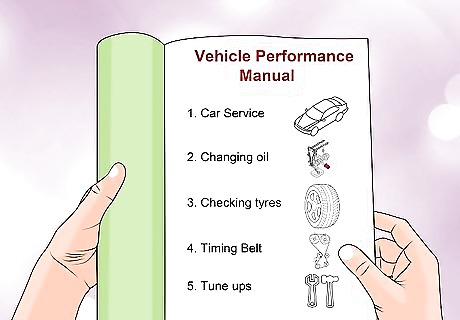
Make simple adjustments to maximize fuel economy and power. Modifying your car to increase its performance will do you very little good if you fail to stay on top of the required maintenance that keeps your car running smoothly. By changing your oil regularly, ensuring your tires are properly inflated, and following the recommended schedule of service for your vehicle, you can make your vehicle perform better and last longer. Check your vehicle’s owner manual for recommended service at different mileage points. Some cars may require timing belt or chain adjustments or fluid changes at specific mileage markers to ensure the vehicle continues to run as it was designed. Professional “tune ups” that include air and fuel filter changes, spark plugs, and even transmission fluid and filter changes are a great way to keep your vehicle running properly. Ensure your tires are inflated to their recommended pressure to improve fuel economy and extend the life of the tire.
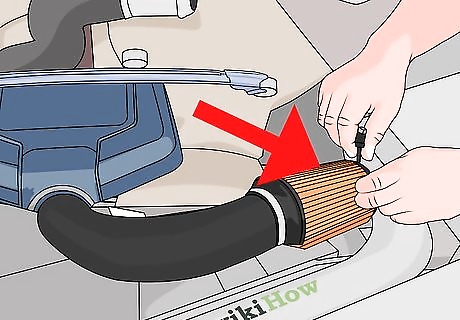
Install a cold air intake. Think of your car as an athlete running a race; the intake on your car is the way it breathes in as it runs. Stock intakes are designed for a number of purposes that include things like reducing engine noise. By replacing your stock intake pipe with one that was designed to maximize power, you will not only increase horsepower, but fuel efficiency as well. Cold air intakes often have a larger diameter than the stock pipe and are designed to take the most direct route to the throttle body as possible. Cold air intakes usually include an aftermarket air filter that increases the filter surface. This allows for more air to travel through it at a higher volume. Some cold air intakes even include heat shielding to prevent the engine temperature from warming the air as it travels into the engine. The cooler the air, the denser it is with oxygen, allowing for a hotter burn which creates more horsepower.
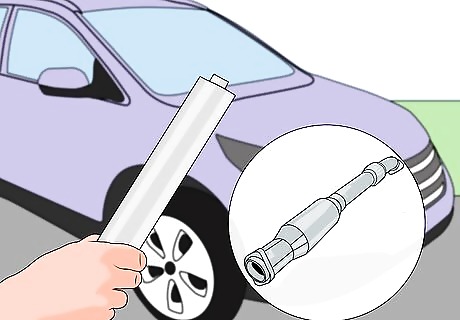
Purchase a higher flowing exhaust. If the intake is how an athlete (your car) breathes in as it runs, the exhaust is how it breathes back out. There are a number of options available to you when it comes to installing higher flowing exhausts. Many people opt to install a catalyst-back aftermarket exhaust, which replaces the piping from your catalytic converter(s) to the muffler. Higher flowing catalytic converters, front pipes and even exhaust manifolds are all also common modifications. Replacing the entire exhaust system (from exhaust manifold to muffler) will maximize the performance of your engine. Larger diameter, higher flowing exhaust systems have a more significant effect on turbocharged vehicles. The increased exhaust flow also serves to increase the efficiency of the turbocharger. Some states have strict regulations about replacing your catalytic converters. Check on the website of your local Department of Motor Vehicles prior to modifying or replacing your catalytic converter. EXPERT TIP Jason Shackelford Jason Shackelford Auto Technician Jason Shackelford is the Owner of Stingray Auto Repair, a family owned and operated auto repair shop with locations in Seattle and Redmond, Washington. He has over 24 years of experience in auto repair and services, and every single technician on Jason’s team has more than 10 years of experience. Jason Shackelford Jason Shackelford Auto Technician Upgraded air intakes and less restricted exhausts add engine power. Two easy ways to get more power from your car are adding a performance air intake and a less restricted exhaust system. The air intake helps the engine breathe better, while the upgraded exhaust lets waste gases escape more freely. Both let the engine work closer to its potential.
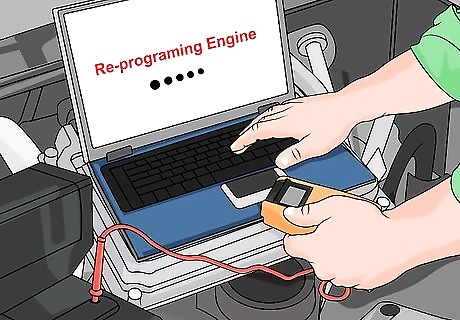
Reprogram your engine control unit. The engine control unit (ECU) in modern cars keeps the engine running smoothly. The ECU adjusts the air/fuel ratio of your engine to keep things consistent regardless of air density (altitude) and temperature. If your engine begins to run lean (too much oxygen), the ECU will add fuel to the mixture to re-achieve balance, and vice versa if the engine starts to run rich (too much fuel). The ratio the ECU maintains is established at the factory and based on a number of factors such as reducing emissions and increasing reliability. By using a programmer or taking your car to a performance shop to have your ECU flashed with a new program that prioritizes performance, you can free up power and even increase gas mileage. Some vehicles can be reprogrammed through their OBDII ports using programmers you can buy for your specific vehicle or “chips” you can install. Higher end models of these programmers allow you to utilize more than one program or profile. This allows you to switch between air/fuel ratios that prioritize performance, gas mileage, or even using lower octane fuel.
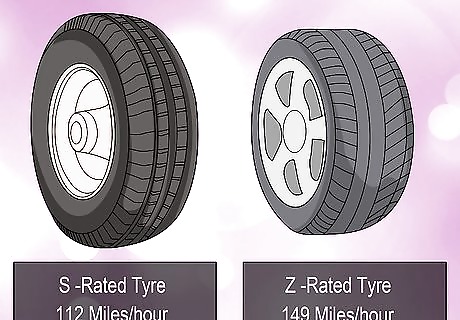
Swap your tires for high performance alternatives. Tires are extremely important to the performance of your car. Good traction determines your car’s ability to put the power it produces to the ground; it’s the difference between getting a good launch and burning your tires at the starting line. Most people choose performance tires designed with a compromise between maximizing the tire’s “footprint” and allowing for water displacing tread. Pay attention to the speed rating on the tires you purchase. The rating is usually a single letter that refers to the maximum speed the tire is rated for. Most cars come with “S” rated tires that are safe up to 112 miles per hour. Many performance tires carry a “Z” rating, which is rated for speeds in excess of 149 miles per hour. Some high performance tires produce more ride noise than their stock alternatives.
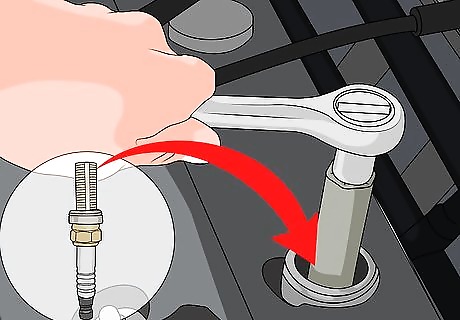
Replace your spark plugs. Spark plugs produce the electrical spark that ignites the mixture of air and fuel in each cylinder of your engine. Over time, they can wear out or become ruined by unfavorable running conditions such as running too lean or rich. Compromised spark plugs have limited ability to ignite the air/fuel mixture, which may result in the engine misfiring. There are many different options when it comes to spark plugs, so do some research or consult the clerk at your local auto parts store when choosing spark plugs to install in your engine. Spark plugs should be replaced at regular intervals as a part of your normal vehicle maintenance to ensure they don’t corrode or fail. Some spark plugs are made from different materials: copper conducts best but has to be replaced far more often due to corrosion, so many people choose iridium plugs for performance applications as they conduct nearly as well and last much longer. Make sure you consult your car’s repair manual when gapping your spark plugs before you install them. The gap on the spark plug is the distance the spark needs to arc from one piece of the plug to another. An incorrect gap height can compromise the plug’s ability to ignite the air fuel mixture.
Improving Your Car’s Handling

Replace your shocks and springs with higher performance alternatives. The shocks and springs in the suspension of your car were designed and built with your comfort in mind. In order to maximize comfort, the suspension allows the wheels to move up and down to limit how much the body of the car is affected by bumps. Replacing these components with stiffer shocks and springs will compromise some of your ride comfort, but the added stiffness will keep the tires in contact with the road better, thus improving traction when accelerating, braking, or turning. Coil-Overs are adjustable shocks and springs that allow you to lower the vehicle and stiffen the ride based on your preference and driving style. Many stiffer suspensions also lower the vehicle, which lowers its center of gravity and also serves to improve handling.
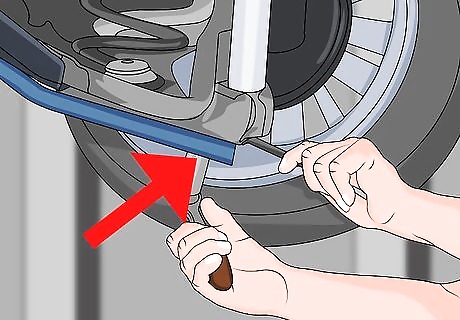
Install larger anti-roll bars. Anti-roll bars cross the undercarriage of your car at the front and rear to connect the sides of the body and increase the structural rigidity of your car. Swapping out the stock anti-roll bars with larger diameter replacements will increase the rigidity of your car’s body even further. This increased stiffness helps to ensure the tires remain as flat as possible on the ground to maintain good traction. When buying anti-roll bars, it’s best to purchase them in pairs so the front and back offer the same level of torsional strength and don’t permit your car to twist under the torque of hard launches or sharp turns. Anti-roll bars are also referred to as sway bars, anti-sway bars, stabilizer bars or roll bars. High strength tubular steel is often a better alternative to solid bars, which can be extremely heavy.
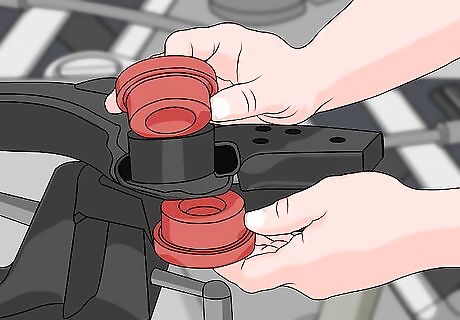
Swap rubber bushings with polyurethane. Your suspension has a number of bushings separating moving metal parts, reducing vibrations and helping to maintain your car’s weight distribution. Unfortunately, the rubber these bushings are made of tends to break down over time. Polyurethane replacement bushings are much stiffer than their rubber counterparts and won’t wear down the way stock ones will. Polyurethane bushings will make loud squeaking noises if not properly greased when installed. Bushings can be replaced one by one or kits can be purchased to replace all of your bushings at once. Some bushings may require the use of a press to remove from their housings.

Install a strut tower bar. Strut tower bars connect the right and left side of your car in much the same way anti-roll bars do, but they are installed on the top of the car under the hood and trunk lid. These bars directly connect the driver’s and passenger’s side struts, increasing the structural rigidity of the car and aiding in efforts to keep the tires as flat on the pavement as possible during aggressive driving. These bars make an excellent addition to after-market anti-roll bars to reduce the amount your car leans and twists while turning. You may not be able to access the rear strut towers to install a bar in the back of some cars. Strut tower bars may need to be removed when working on the engine of your car in the future.
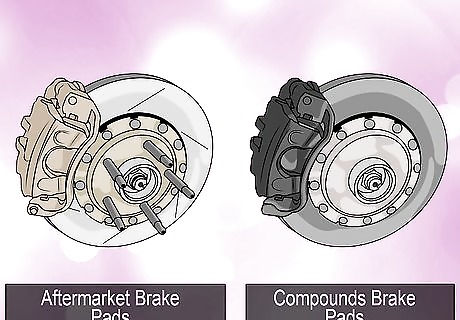
Upgrade your brakes. One could argue that being able to stop is the most important part of any car’s performance. The better quality your brakes, the longer you can wait to engage them before a turn, which means maintaining a higher rate of speed longer than your competitors. You have lots of options when it comes to upgrading your brakes, from purchasing better brake pads to replacing the entire system with larger, heavier duty components. Aftermarket brake pads are designed to improve your car’s ability to stop. They use the stock brake components and are a great option for most street applications. Different brake pad compounds are designed for different uses. Ask your local auto parts store about the options available for your specific car. Kits can be purchased to replace your car’s brake calipers and rotors with larger ones, increasing the friction surface of the brake pad and improving your ability to stop. It’s important to ensure your wheels are large enough to clear big brake upgrades.
Adding Forced Induction or Nitrous Oxide
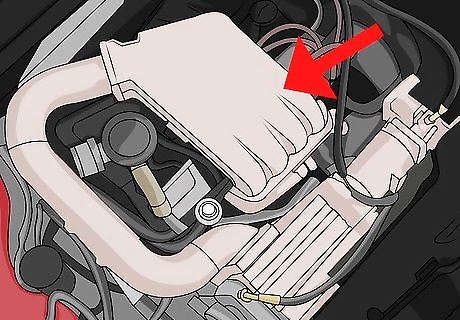
Install a turbocharger kit. Turbochargers are basically air pumps that are powered by the exhaust gas exiting your engine. The exhaust exiting your engine spins a turbine, which transfers that energy through a driveshaft to a turbine on the other side that sucks in and compresses air into your engine’s intake. In effect, a turbocharger forces more air into the engine than it could possibly take in through normal aspiration. Most turbocharger kits include higher volume fuel pumps, ECU programmers, higher flow fuel pressure regulators and even fuel injectors. Turbocharger kits should be purchased for your specific car unless you are an experienced mechanic. Many turbocharged cars have intercoolers installed between the turbocharger and the car’s intake to cool the air and increase its density. Turbocharging your car requires extensive tuning of the air/fuel ratio that may be best left to professionals.
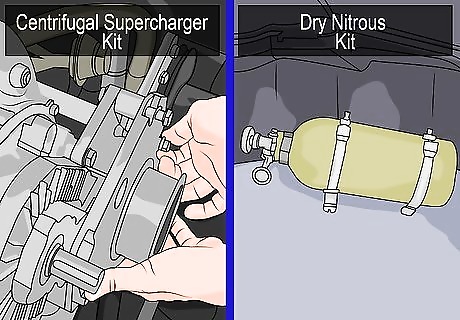
Supercharge your car. Centrifugal superchargers and turbochargers work in very similar ways. While a turbocharger is powered by the exhaust leaving the engine, superchargers are belt driven like your car’s power steering pump or air conditioner. Being belt driven means superchargers aren’t as efficient as turbochargers, but they don’t have to wait to be spooled by the exhaust. Because of this distinction, many people prefer superchargers for their more consistent distribution of power. Installing a supercharger kit involves most of the same modifications required for turbochargers in terms of fuel. Roots style superchargers do not mount in the same way but are still belt driven. These superchargers are traditionally found on older model, carbureted engines. On forced induction applications like supercharged cars, you should use a higher octane fuel to increase the stability of the air/fuel mixture in the engine.
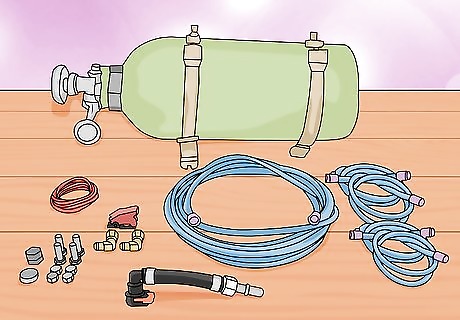
Add a “dry” nitrous kit to your car. Nitrous oxide is a gas that contains more oxygen than the regular air found in the atmosphere. As a result, adding nitrous oxide to the air traveling through your car’s intake serves a similar purpose to forcing more air into it with a turbocharger or supercharger. Instead of forcing more air into the engine mechanically, nitrous oxide introduces more molecules of oxygen into the same amount of space regular air would normally occupy. Nitrous kits that do not mix the nitrous oxide with fuel when injected are referred to as “dry.” These kits are designed to add a smaller amount of power as compared to wet kits, but can be an extremely cost effective method of giving your car a quick horsepower boost. Nitrous oxide kits only affect power output when they are in use, reducing the wear and tear on your engine as compared to consistent power adders like turbochargers and superchargers. After turning on your nitrous kit, you usually control the spray of nitrous with a button or throttle switch that activates when you press the pedal to the floor. Some dry nitrous kits use the fuel pressure regulator to increase fuel pressure going into the engine to compensate for the added oxygen, while some others do not.
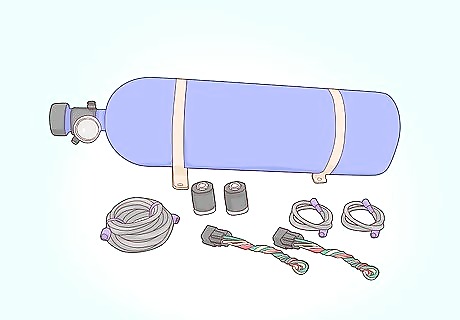
Install a wet nitrous kit in your car. Wet nitrous oxide kits serve the same basic function as their dry counterparts, but they mix fuel directly with the nitrous as it is injected into the engine. As a result, wet nitrous kits are often considered to be safer for your engine, as the air/fuel ratio you choose is maintained even with the addition of the nitrous oxide. This stability allows for wet nitrous kits to add even more horsepower than dry kits with relatively low risk of pre-detonation. Like turbochargers and superchargers, properly utilizing nitrous oxide in your car might require custom tuning that may be beyond most hobby mechanics. Wet nitrous oxide kits are usually engaged using buttons just like dry kits. Nitrous oxide is not flammable on its own like movies might have you believe. It must be mixed with a fuel to burn. Nitrous oxide kits can be used in conjunction with a turbocharger or supercharger.
















Comments
0 comment